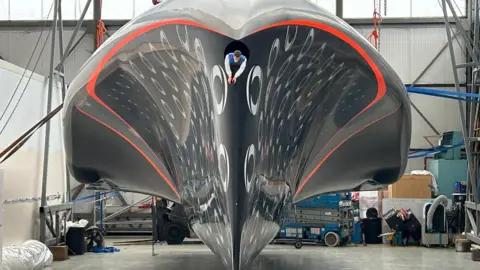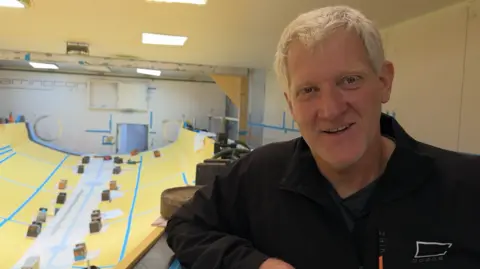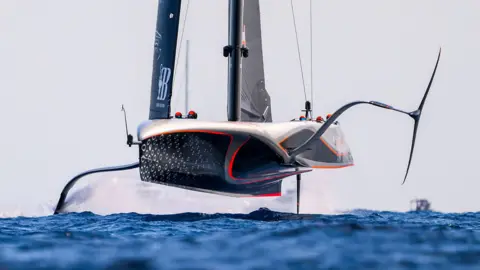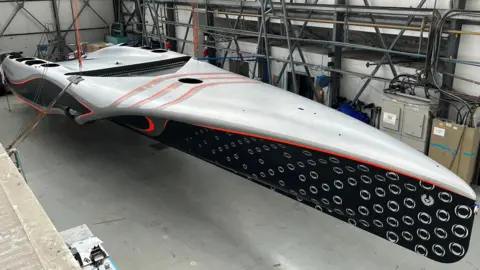Cutting-edge technology powers GB to America's Cup
 Carrington Boats
Carrington BoatsPerched on the edge of Southampton Water, in between the booming of heavy machinery and the sqawking of sea gulls overhead, another noise cries out into Hythe Marine Park. The droning is coming from giant ovens, but these are not baking bread - they are cooking boats.
Carrington Boats in Hythe, Hampshire build racing yachts for the very pinnacle of the sport.
The boat Britain's battle-hardened Ben Ainslie and his Ineos crew will sail in this weekend - AC75 RB3 - was built there, by Jason Carrington and his team of specialists.
Great Britain will compete for the America's Cup for the first time since 1964 after beating Italy 7-4 in a qualifying event in Barcelona.
Mr Carrington says constructing boats of this calibre is right at the top of the game and they are the "Formula 1 of sailing".
"It's cutting-edge technology both in design and build - very exotic materials and very little of them," he continues.

The America's Cup - the oldest international sporting competition in the world, having started in 1851 - has never been won by Great Britain.
The technology involved in building a modern boat would be unrecognisable to those initial crews 173 years ago.
Building the hull takes place in a giant oven - curing the resin which holds each skin-component together.
An America's Cup boat hull consists of two skins of carbon fibre less than half a millimetre thick. The skins sit either side of a honeycomb aluminium core.
The oven is turned on and set to 85C (185F) for roughly 10 hours.
The skin, which up until this point has been attached to a large carbon fibre mould, breaks away, leaving an extremely stiff and - most importantly - ultralight structure.

"The best way to describe it is like a sandwich but with very thin slices of bread - very expensive and exotic bread", Mr Carrington says.
It is not a structure that is strong on impact. Walking on them or kneeling on them can cause them to dent.
"Sometimes, when we watch people on TV walking across the deck we're thinking, 'Oh God, what are you doing?'," Mr Carrington continues.
The super-lightweight materials used to make an AC75 are part of what make them so formidable on the water - reaching speeds of more than 50 knots (58mph).
Mr Carrington says the fact these boats are now foiling "is a huge development".
What is foiling?
 Getty Images
Getty ImagesThe term foiling refers to the use of hydrofoils which are attached to the hull. They allow the boat to lift out of the water when the boat gains speed.
With a foil wing underneath the water, a pressure difference is created both below the wing and above it.
The crew can then adjust the foils and rudder to adjust ride height and angle of attack.
"It's like an aeroplane but put the wing in the water,," Mr Carrington explains.
"There is very little of the boat actually in the water once it's on the foils."
In terms of speed, Mr Carrington thinks the question of whether these boats can get any faster remains illusive.
"We always think these boats can't get any faster or can't develop more but they always do," he says.
"The other day INEOS hit over 55.5 knots (64mph) on a bear away, which is staggering.
"I have a pretty effective powerboat that doesn't get close to that."
While there is no wood anywhere to be seen on these lightning-fast racers, the traditional, perfectionist approach from his workforce are what Mr Carrington describes as the "backbone" to the whole system.
"Yes it's all carbon fibre and aluminium honeycomb but you still need the skills to work with it," he says.
"You simply can't build these boats without an extremely talented workforce - they are a rare breed."
 Carrington Boats
Carrington BoatsWhen the boat is ready to leave the yard, the rig and all the systems are yet to be fitted.
The systems are installed by Mercedes F1 and the rig and sails are manufactured elsewhere.
The sail is often chosen and hoisted less than 45 minutes before a race, depending on wind speed and sea state.
AC75 RB3 will be put through its paces once again when Britain's most successful sailor Ben Ainslie and his crew face New Zealand in the America's Cup in Barcelona.
The racing starts on Saturday 12 October and the best of 13 contest is scheduled to run until 21 October.
You can follow BBC Hampshire & Isle of Wight on Facebook, X (Twitter), or Instagram.
